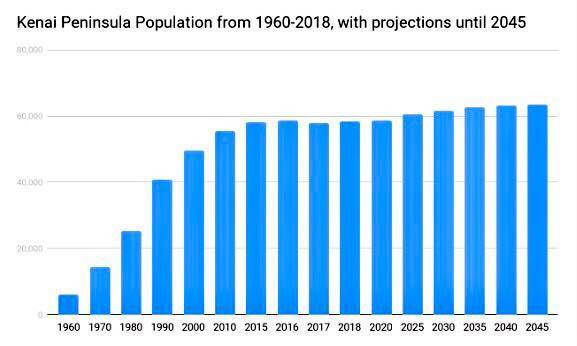Alaska’s population decreased for the second year in a row. From July 2017 to July 2018, the state lost 1,608 people, or 0.2 percent of the total population, based on a new report from the Alaska Department of Labor and Workforce Development.
The state’s total population peaked in July 2016 at 739,676. As of July 2018, the population was at 736,239.
Of Alaska’s 29 boroughs, 18 lost population between 2017 and 2018. The Kenai Peninsula Borough gained population during this time.
The biggest losses were in the Municipality of Anchorage with a loss of 2,386 people and the Fairbanks North Star Borough who lost 734 people. The Matanuska-Susitna Borough gained 1,355 people.
Alaska’s population is continuing to grow older. Between July 2017 and July 2018, the population of Alaskans ages 0-64 declined by 0.9 percent while Alaskans age 65-and-older increased over 5 percent.
Alaska has the fastest growing population of people age 65 and older in the country, according to the Alaska Commission on aging. The commission projects the aging populating will double by 2042 before declining. According to the report, the oldest borough was Haines, with a median age of 48.6 years old. The state’s median age is 35.2 years old. The Kenai Peninsula’s median age was 41.5.
According to the state’s report, the Kenai Peninsula Borough, which is home to an estimated 58,471, had a net gain of 361 people between 2017 and 2018, or a growth rate of .62 percent. The borough has seen an increase in population since the 1960s, however, between 2016 and 2017, the borough saw a slight decrease in population. Since 2015, the borough’s population has stayed steady around 58,000 people.
The state released their population projections in 2018, and the Kenai Peninsula is expected to slowly increase to a population of 58,696 by 2020. By 2045, the borough may be home to 63,472 people.
Tim Dillon, executive director of the Kenai Peninsula Economic Development District, said those numbers could increase if certain projects, the Alaska LNG project, are fulfilled.
“A lot depends on potential opportunities we have on the peninsula,” Dillon said.
Dillon said the Alaska LNG project would need 10,000 employees during the construction phase, and then 1,000 permanent employees.
“For every one worker, there is an impact of 20 or more jobs,” Dillon said.
Migration estimates from the U.S. Census show hundreds of borough residents left the borough between 2012 and 2016 and moved to counties in Arkansas, Arizona, California, Florida and Texas. Many residents who moved to the borough between 2012 and 2016 came from many other boroughs in Alaska, including Bethel, Prince of Wales-Hyder Census Area and Anchorage municipality. More than a hundred new borough residents came from Oregon and Colorado during that time.

